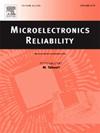回流焊装配过程中铜柱节距尺寸的热-力学分析
IF 1.9
4区 工程技术
Q3 ENGINEERING, ELECTRICAL & ELECTRONIC
引用次数: 0
摘要
本文研究了回流焊过程中不同节距尺寸对铜柱凸点热性能和力学性能的影响。将模拟回流温度与实验结果进行了比较,两者吻合较好。流场模拟结果表明,辐射传热是回流炉内的主要传热方式。此外,传热受到气流循环的影响,导致温度分布不均匀,凸起之间存在温度偏差。仿真结果表明,总体回流温度、凸点峰值温差、变形和应力应变分布对铜柱凸点可靠性有显著影响。当节距为0.40 mm时,总变形较小,应力分布最小。因此,本研究为监测铜柱凸点的温度分布及其抗变形和应力应变能力提供了全面的指导,这是在回流焊组装过程中获得高质量键合和可靠电子产品的关键标准。本文章由计算机程序翻译,如有差异,请以英文原文为准。
Thermal-mechanical analysis of copper pillar pitch size during reflow soldering assembly process
This study investigates the effect of pitch sizes on the thermal and mechanical performance of the copper (Cu) pillar bumps during the reflow soldering assembly process. The simulated reflow temperature is compared with the experimental result, which is in good agreement. The simulated flow field reveals that radiation is the dominant heat transfer mode in the reflow oven. Moreover, the heat transfer is affected by airflow circulation, leading to uneven temperature distribution and temperature deviations between the bumps. The simulation results demonstrate that overall reflow temperature, the temperature difference between peak temperatures of bumps, deformation, and stress-strain distribution significantly impact Cu pillar bump reliability. Pitch size of 0.40 mm yielded minor total deformation and the lowest stress distribution. Thus, this study provides a comprehensive guide for monitoring the temperature distributions on Cu pillar bumps and their capability to resist deformation and stress strain, which are crucial criteria for achieving high-quality bonding and reliable electronic products during the reflow soldering assembly process.
求助全文
通过发布文献求助,成功后即可免费获取论文全文。
去求助
来源期刊

Microelectronics Reliability
工程技术-工程:电子与电气
CiteScore
3.30
自引率
12.50%
发文量
342
审稿时长
68 days
期刊介绍:
Microelectronics Reliability, is dedicated to disseminating the latest research results and related information on the reliability of microelectronic devices, circuits and systems, from materials, process and manufacturing, to design, testing and operation. The coverage of the journal includes the following topics: measurement, understanding and analysis; evaluation and prediction; modelling and simulation; methodologies and mitigation. Papers which combine reliability with other important areas of microelectronics engineering, such as design, fabrication, integration, testing, and field operation will also be welcome, and practical papers reporting case studies in the field and specific application domains are particularly encouraged.
Most accepted papers will be published as Research Papers, describing significant advances and completed work. Papers reviewing important developing topics of general interest may be accepted for publication as Review Papers. Urgent communications of a more preliminary nature and short reports on completed practical work of current interest may be considered for publication as Research Notes. All contributions are subject to peer review by leading experts in the field.
 求助内容:
求助内容: 应助结果提醒方式:
应助结果提醒方式:


